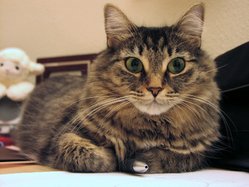

Custom Search
|
 Brown mackerel tabby domestic longhair
Brown mackerel tabby domestic longhair
Tabby cats are often mistaken as a certain breed of cat. The term tabby actually refers to the stripes, dots and swirling patterns of the cat's coat. The tabby pattern is believed to be the original basic cat pattern, and the closest to their distant ancestors. Tabby coloration is found in many breeds of cat, as well as among the general 'moggy' (mixed-breed or mongrel) population. When cats are allowed to breed randomly, the coloration of the population tends toward brown mackerel tabbies with green eyes, leading geneticists to believe that this is the common wild phenotype of the domestic cat.
The word comes from French tabis, which was earlier atabis, and in medieval Latin attabi. The initial origin of the word seems to be from the Attabiyah section of Baghdad where a type of striped silk was made that was later used to describe cats.
There are three tabby patterns that have been shown to be genetically distinct, classic, mackerel and ticked, and a fourth variation, spotted, that is still undergoing debate as to its cause. The color most recognizable as a tabby is called brown tabby in the US and black tabby in the UK. Technically it is a black cat with an agouti gene that causes the fur to break into patterns of black and brown. While the name black tabby is more correct, the brown tabby moniker is firmly established in the US and any change is doubtful. It is possible to have a black, blue, red, and cream in classic, mackerel, ticked and spotted patterns. Chocolate, cinnamon, lilac and fawn generally only appear in the ticked pattern, most commonly in the Abyssinian and Somali breeds.
The mackerel tabby pattern is the most common as the gene for this is dominant to the classic pattern. The mackerel pattern is what people commonly think of when they think of tabby. It has vertical, gently curving stripes on the side of the body. The stripes are thin and may be continuous or broken into bars and spots on the flanks and stomach. Often, an M shape appears on the forehead. The Maine Coon breed often appears in brown mackerel tabby.
Classic (or blotched) tabbies have a similar pattern on the head of the cat, but the body markings are very different. They have a whorled and swirled pattern with thicker stripes that make what are referred to as butterfly patterns on their shoulders. The legs and tail are more heavily barred and the pattern is variable with respect to the width of the bands. American shorthairs are often exhibited in silver classic tabby.
The ticked tabby pattern produces hairs that have distinct bands of color on them, breaking the tabby patterning up into a salt-and-pepper appearance. However, ghost striping or barring can often be seen on the legs, face and belly. It is difficult to produce a cat with a solid ticked coat.
In order of genetic dominance, the ticked pattern is dominant to the mackerel pattern, which is dominant to the classic pattern. However, all of these patterns have been observed in random bred populations.
The spotted tabby may not be actual pattern, but a modifier that breaks up the tabby markings. The stripes of the mackerel pattern are broken to the extent that they appear as spots, rather than stripes.
Tabby patterns are dominant over all other patterns except for white masking and piebald white spotting or bicolor. It is possible to have a tabby pattern exhibited in the color patches of a tortoiseshell pattern. These cats are called torbies or tabby torties.
Many tabbies have a distinct 'M' marking on their forehead, which is the mark of the true tabby. There are several legends about where this came from, including one that the Virgin Mary bestowed an M on a tabby's head because the cat helped keep the baby Jesus warm. There is another legend to explain the M, where the prophet Mohammed bestowed the marking upon his beloved cat's brow after it warned him of danger. According to the legend, the M remains today to remind us of Mohammed's blessings upon cats.

Red mackerel tabby showing the classic 'M' mark on forehead.
|

A blue mackerel tabby.
|

Brown mackerel tabby
|

Red North American short-hair tabby.
|
Cats, made by MultiMedia | Free content and software
This guide is licensed under the GNU Free Documentation License. It uses material from the Wikipedia.